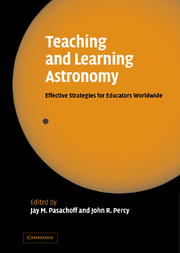Book contents
- Frontmatter
- Contents
- List of illustrations
- Preface
- Introduction
- Part I Astronomy in the curriculum around the world
- Introduction
- 1 Why astronomy is useful and should be included in the school curriculum
- 2 Astronomy and mathematics education
- Open discussion
- 3 Engaging gifted science students through astronomy
- Poster highlights
- Part II Astronomy education research
- Part III Educating students
- Part IV Educating teachers
- Part V Astronomy and pseudoscience
- Part VI Astronomy and culture
- Part VII Astronomy in developing countries
- Part VIII Public outreach in astronomy
- Part IX The education programs of the International Astronomical Union
- Part X Conclusions
- Author index
- Subject index
2 - Astronomy and mathematics education
Published online by Cambridge University Press: 18 May 2010
- Frontmatter
- Contents
- List of illustrations
- Preface
- Introduction
- Part I Astronomy in the curriculum around the world
- Introduction
- 1 Why astronomy is useful and should be included in the school curriculum
- 2 Astronomy and mathematics education
- Open discussion
- 3 Engaging gifted science students through astronomy
- Poster highlights
- Part II Astronomy education research
- Part III Educating students
- Part IV Educating teachers
- Part V Astronomy and pseudoscience
- Part VI Astronomy and culture
- Part VII Astronomy in developing countries
- Part VIII Public outreach in astronomy
- Part IX The education programs of the International Astronomical Union
- Part X Conclusions
- Author index
- Subject index
Summary
Abstract: There are many European countries in which astronomy does not appear as a specific course in secondary school. In such cases, astronomy can be introduced through other subjects. This paper concerns astronomy in mathematics classes. Teaching astronomy through mathematics would result in more exposure than through physics, for instance, because mathematics is more prevalent in the curriculum. Generally, it is not easy to motivate students in mathematics, but they are motivated to find out more about the universe, and about astronomy current events which appear in the media. This provides an excellent introduction to several mathematics topics. Specific connections include: angles and spherical coordinates to star trails; logarithms to visual magnitudes; plane trigonometry to orbital motion; spherical trigonometry to the obliquity of the ecliptic; and conic curves to sundials at various latitudes. These practical, applied connections make mathematics courses more attractive to students.
Astronomy in mathematics in schools
Astronomy has an interdisciplinary aspect that is potentially very positive. It is good to combine astronomy with other topics and to introduce astronomy in general projects in school in order to integrate several courses, for instance physics, mathematics, geography, biology or history. However, these kinds of project are sporadic. Of course, it is a good idea to promote them, but it is not possible to organize the astronomical education of young people with only this kind of project. It can be positive for astronomy to appear as a small part of other subjects. If astronomy appears in several subjects, this communicates to the students astronomy's interdisciplinary nature, which is very positive.
- Type
- Chapter
- Information
- Teaching and Learning AstronomyEffective Strategies for Educators Worldwide, pp. 14 - 24Publisher: Cambridge University PressPrint publication year: 2005
- 1
- Cited by

